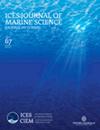Geohistorical insights into marine functional connectivity
IF 3.4
2区 农林科学
Q1 FISHERIES
引用次数: 0
Abstract
Marine functional connectivity (MFC) refers to the flows of organic matter, genes, and energy that are caused by the active and passive movements of marine organisms. Occurring at various temporal and spatial scales, MFC is a dynamic, constantly evolving global ecological process, part of overall ecological connectivity, but with its own distinct and specific patterns. Geological and historical archives of changes in the distributions, life histories, and migration of species can provide baselines for deciphering the long-term trends (decadal to millions of years) and variability of MFC. In this food-for-thought paper, we identify the different types of geohistorical data that can be used to study past MFC. We propose resources that are available for such work. Finally, we offer a roadmap outlining the most appropriate approaches for analysing and interpreting these data, the biases and limitations involved, and what we consider to be the primary themes for future research in this field. Overall, we demonstrate how, despite differences in norms and limitations between disciplines, valuable data on ecological and societal change can be extracted from geological and historical archives, and be used to understand changes of MFC through time.海洋功能连接的地史洞察力
海洋功能连通性(MFC)是指由海洋生物的主动和被动运动所引起的有机物、基因和能量的流动。海洋功能连通性发生在不同的时间和空间尺度上,是一个动态的、不断演变的全球生态过程,是整体生态连通性的一部分,但又有其独特和特定的模式。有关物种分布、生活史和迁徙变化的地质和历史档案可为解读 MFC 的长期趋势(十年至数百万年)和可变性提供基准。在这篇启发思考的论文中,我们确定了可用于研究过去多变海洋生态系统的不同类型的地质历史数据。我们提出了可用于此类工作的资源。最后,我们提供了一个路线图,概述了分析和解释这些数据的最合适方法、所涉及的偏差和局限性,以及我们认为该领域未来研究的首要主题。总之,我们展示了尽管各学科之间存在规范和限制方面的差异,但如何从地质和历史档案中提取有关生态和社会变迁的宝贵数据,并利用这些数据来了解 MFC 随时间发生的变化。
本文章由计算机程序翻译,如有差异,请以英文原文为准。
求助全文
约1分钟内获得全文
求助全文
来源期刊

ICES Journal of Marine Science
农林科学-海洋学
CiteScore
6.60
自引率
12.10%
发文量
207
审稿时长
6-16 weeks
期刊介绍:
The ICES Journal of Marine Science publishes original articles, opinion essays (“Food for Thought”), visions for the future (“Quo Vadimus”), and critical reviews that contribute to our scientific understanding of marine systems and the impact of human activities on them. The Journal also serves as a foundation for scientific advice across the broad spectrum of management and conservation issues related to the marine environment. Oceanography (e.g. productivity-determining processes), marine habitats, living resources, and related topics constitute the key elements of papers considered for publication. This includes economic, social, and public administration studies to the extent that they are directly related to management of the seas and are of general interest to marine scientists. Integrated studies that bridge gaps between traditional disciplines are particularly welcome.
 求助内容:
求助内容: 应助结果提醒方式:
应助结果提醒方式:


